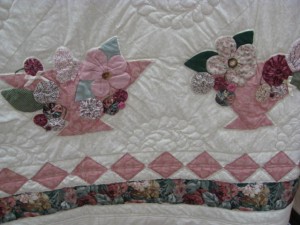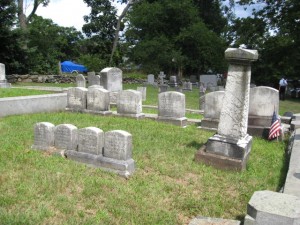In 2008, Leicester native B J Hill started walking across America. Yes, really, he started walking in San Francisco and thousands of miles later ended up in Boston’s Copley Square. I had heard about him, of course, because he’s a local guy and a couple of the weekly papers had featured his story. I had it in my mind that I wanted to meet him and hear more about his adventure, and tonight I got my wish: as I drove through West Brookfield on my way to work this morning, I saw a sign outside the library saying that he would be speaking this evening. At 6:30 a small group of us gathered in the upstairs meeting room at the Merriam Library to listen to his talk.
Mr Hill’s presentation was as fascinating as I hoped it would be. He began by telling us that as a child, around 8 or 10 years old, he read about famous walkers and kept their stories in the back of his mind. He grew up in Leicester, attended St John’s and then Northeastern University, served in AmeriCorps, and trained with the American Red Cross (in fact, he was a first responder for the Sept 11th disaster in New York City). A restless, outgoing young man, he taught in Japan for two years, earned a second bachelor’s degree at Worcester State, and volunteered to help with Hurrican Rita. In 2006, he moved to Ohio, but he missed the outdoors and soon returned to Massachusetts. That year, more or less on an impulse, he walked across Massachusetts, from the Berkshires in the northwest to Cape Cod in the southeast. At the time, there were four strong candidates running for governor of Massachusetts, and he began asking people he met along his walk what they would like to say to the next governor. He collected their responses in a notebook, and eventually was able to meet with newly-elected Governor Deval Patrick and talk about his experience listening to ordinary folks, from all walks of life, in all corners of the Commonwealth.
In 2008, Mr Hill decided to take on the challenge of doing the same thing on a national level. It was a presidential election year, and he wanted to ask people to record messages for the new president. He spent 2007 planning the walk; he needed to take weather into consideration, find places to stay, build a website, make media contacts, reach out to sponsors, and budget for food and supplies. He also bought three sturdy notebooks, as well as plastic bags to protect them. On March 1, 2008, he started his walk at the Golden Gate Bridge. Seven months and 4250 miles later, he accomplished his goal on January 19, 2009, when he walked into Boston. Because of some contacts that he had made on the way, he was able to attend the inauguration of President Obama in Washington DC on the following day, January 20.
With this goal accomplished, Mr Hill started a new career in IT, and he continued to volunteer for disaster relief efforts. He served in Haiti, and in 2011 worked on tornado relief efforts in Alabama, in the very location he had passed through on his walk three years before. People kept asking him, “What happened to the messages?” and he decided that he really needed to go the extra mile and deliver them to the President. Through a fortunate encounter in Senator Kerry’s office in Washington, he was finally able to set up a meeting with President Obama. In the spirit of his enterprise, he walked 450 miles from Massachusetts to Washington DC, collecting more messages along the way, and on December 1, 2011 had his “fifteen minutes of fame,” sitting across from the President and passing along the books of messages. Mr Hill was thrilled that the President was so gracious and engaged, and told us that he will treasure the official photograph of them together.
As you might imagine, Mr Hill took a lot of photographs and could have told stories all evening, but his time was limited (the library closes at 8 pm on Thursdays). After all, he covered four major regions of our country, the West, the Midwest, the Deep South, and the Eastern Seaboard, walking through California, Nevada, Utah, Wyoming, Nebraska, Iowa, Missouri, Illinois, Kentucky, Tennessee, Mississippi, Alabama, Georgia, South Carolina, North Carolina, Virginia, District of Columbia, Maryland, Delaware, Pennsylvania, New Jersey, New York, Connecticut, and Massachusetts. I took copious notes but won’t reproduce them here. Instead, I’ll share some of the more interesting (to me) aspects of his adventure:
- He ate a lot of apples, cheese, and beef jerky, and wore out seven pairs of shoes
- He sometimes had good media coverage (Salt Lake City) but often did not
- He met multitudes of friendly and helpful people, some of whom he is still in touch with
- Senior Centers and public libraries were good places for him to meet with people
- He often camped on the town greens or stayed with local families
- The Sierra Nevada was the most demanding part of the walk, which happened at the very beginning
- Highway 50 in Nevada is called the “Loneliest Highway” and it deserves that moniker
- Some of the famous sights he saw included the Shoe Tree in Nevada and the world’s largest Superman statue in Illinois
- Out West, towns were often built along the railroad lines, and are spaced 25-30 miles apart
- In high summer in Iowa, he encountered a lot of hills, heat, and humidity
- He enjoyed being able to walk on a rail trail from Alabama to Atlanta
- A lot of messages were about high gas prices, and then after the October stock market crash, about the economy
- In North Carolina, he met another cross-country walker who was going from east to west
- While he was in Virginia, Election Day, November 4, came and went
- In Washington DC, he met with Senator Kerry’s staff and visited Senator Kennedy’s office
- In New York, he chose to bypass New York City and walk along the Hudson River instead
- On the final leg of his journey through Massachusetts, when he passed through Spencer, Leicester, and Worcester, it was very cold
- The messages he collected in 2011, when the President had been in office three years, were more focused on specific issues
I’ve often wondered if I could make such a journey, and though I might have the energy and physical stamina, I don’t think I have the right personality. But Mr Hill was an inspiring speaker. He acknowledged with gratitude those who had gone before him, men such as Peter Jenkins (author of the books A Walk Across America and The Walk West) and Robert Sweetgall, and thanked all those who helped him along the way. He encouraged us to consider accomplishing a project like this one, and who knows, maybe I will some day.






